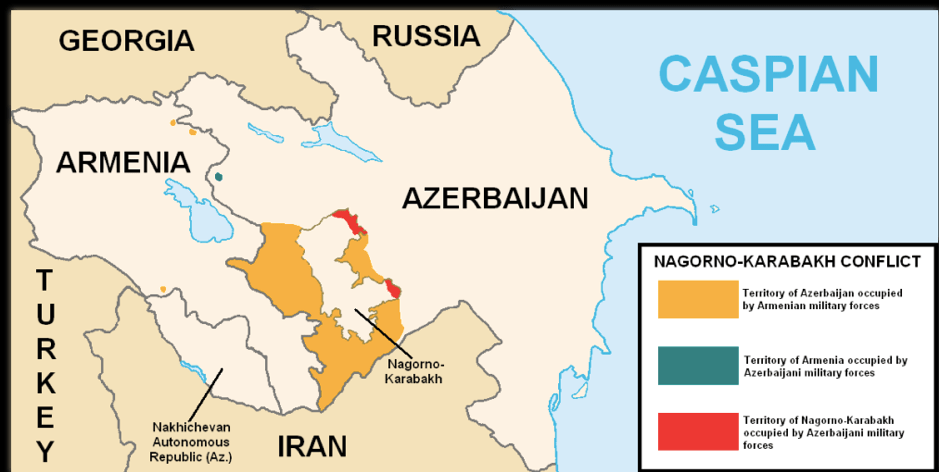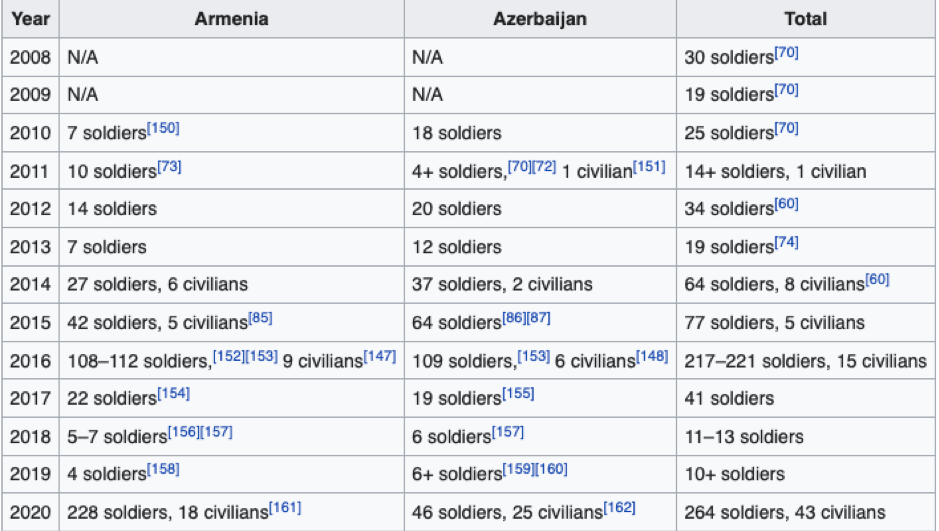Table of Contents
Introduction & Background
Recently, Azerbaijan and Armenia have been in the news again for their infamous conflict in the Nagorno-Karabakh region. There have been ceasefire violations in the region and both the countries have blamed each other for the unnecessary provocation.
This conflict of Nagorno-Karabakh though is not new. It has been in the news since its official inception in the late 1980s.
What is Nagorno-Karabakh?
The Nagorno-Karabakh territory is a disputed region in the South Caucasus and is inhabited mostly by the ethnic Armenians. In a geographical and historical sense, Nagorno-Karabakh is an internationally recognized part of Azerbaijan, though currently, it is ruled by the non-recognized and self-proclaimed Republic of Artsakh*.
Nagorno-Karabakh became a part of Soviet Azerbaijan in 1923 under the Soviet Union. Soon after, Nagorno-Karabakh was given the status of an autonomous oblast*. Joseph Stalin was the one who transferred the Nagorno-Karabakh region under Azerbaijan as Turkey was the Soviet Union’s ally then.
What people of the Republic of Artsakh want?
The Republic of Artsakh consists mostly of ethnic Armenians who self-declared their independence in 1991 and from then are ruling the Nagorno-Karabakh region with the support of Armenian forces.
As per the demands, the people of the Republic of Artsakh have always wanted the Nagorno-Karabakh region to be either recognized as an independent state or be united with Armenia.
The region of Nagorno-Karabakh is sometimes also referred to as an “Enclave” as it consists majorly of ethnic Armenians surrounded by Azerbaijan’s territory

Nagorno-Karabakh is a mountainous region inside the borders (Southwestern region) of Azerbaijan. The conflict started when the Soviet Union* was dissolved in 1989. It is said that the tension between the two nations over the disputed region has been there for a very long time, but any uprising was always suppressed under the rule of the Soviet Union.
It all started when the Karabakh Armenians demanded to secede from Azerbaijan and be recognized as a part of Armenia or as an independent state as they had the majority population in the region. Of course, Azerbaijan never wanted that. They wanted to maintain their territorial integrity.
Armenia is majorly a Christian while Azerbaijan is majorly a Muslim state.
Nagorno-Karabakh Conflict
The Nagorno-Karabakh war was the first known conflict between Armenia and Azerbaijan that took place between 1988 – 1994. This war was also known as Artsakh Liberation War. The war took place between ethnic Armenians part of the Nagorno-Karabakh region (backed by Armenia forces) and the Azerbaijan forces.
A referendum was organized in the February of 1988 by the Autonomous Oblast of Nagorno-Karabakh region if it should be united with Armenia or not. The referendum was boycotted by the Azerbaijani people of the region, so ultimately most of the votes went in favor of the region to be united with Armenia.
This move proved to be the boiling point for the conflict. Once the Soviet Union was dissolved, Azerbaijan declared its independence while the people of the Nagorno-Karabakh region raised voices to secede from Azerbaijan. Both countries resorted to ethnic cleansing. Many people from both sides lost their lives in the conflict.
In 1992, the conflict was at its peak. Various countries tried to mediate but to no effect. In 1994, the Armenian forces occupied Nagorno-Karabakh region and some territory outside the region, part of Azerbaijan.
From the numbers perspective, it is noted that over 200K Armenians from Azerbaijan and over 800K Azerbaijani’s from Armenia and Karabakh region were displaced as part of the war. The ceasefire was mediated by Russia in 1994. The figures say that almost 30K people were killed in the conflict.
OSCE Minsk Group
In 1992, OSCE Minsk was formed by Conference on Security and Co-operation in Europe (CSCE) which is now called Organization for on Security and Co-operation in Europe (OSCE). The objective of the group is to resolve the Nagorno-Karabakh conflict in a peaceful way.
The group consists of majorly three nations: France, United States, and Russia that are co-chairs.
The other nations of the group are Belarus, Italy, Germany, Netherlands, Portugal, Sweden, Turkey, Finland, Azerbaijan, and Armenia.
Noted Clashes in Nagorno-Karabakh after 1994
2008
The Martakert* clashes of 2008 happened between the ethnic Armenians and Azerbaijan forces over the disputed region of Nagorno-Karabakh. This happened when there was unrest in Armenia relating to the elections. The Armenians accused that Azerbaijan was taking undue advantage of the protests in Armenia.
Later, a resolution 62/243 was passed by the United Nations General Assembly stating that Armenian forces should be withdrawn from the all the occupied Azerbaijan territories.
2010
Series of ceasefire violations were recorded in 2010 along the line of contact dividing Azerbaijan and the Republic of Artsakh. Armenian forces suffered huge casualties in these clashes.
2016
Between 1st and 5th April 2016, heavy fighting broke out between Azerbaijan and Armenian forces. As per the records, there were around 100 casualties on both sides.
2020
On 27 September 2020, the clashes were re-initiated between the two groups in the disputed region of Nagorno-Karabakh. Both nations declared Martial Law. Curfew was also implemented in some regions of both countries.
The Martial Law and mobilization of troops means that the two nations could be on the brink of another war. The clash is considered worse than that of 2016 as more people have been killed.
Most of the countries have asked the two nations to negotiate and settle the matter peacefully. The nations have also urged the United Nations to act and intervene so that stability is maintained in the disputed region and within both nations.
Three ceasefires have been brokered till now (two by Russia and one by the US), but they failed to hold.
Hundreds of people have been killed and thousands have been displaced already. As per Armenia, till now, over 800 of its troops have been killed in the recent clashes.
Involvement and stand of other countries in the Nagorno-Karabakh conflict
Turkey (Nagorno-Karabakh should remain a part of Azerbaijan)
Turkey is the only nation that has officially extended its support to Azerbaijan in the conflict. It also supports Azerbaijan politically. Turkey has been and is providing military aid to Azerbaijan as part of the conflict.
In support of Azerbaijan, Turkey shut its border with Armenia in 1993. The relationship between Turkey and Armenia was hampered when the Ottoman Empire killed over 1.5 million Armenians.
Another reason for Turkey backing Azerbaijan is that the ethnicity and linguistics of Turkey are similar to those of Azerbaijan. Also, a strong Armenia was seen as a threat for Turkey and its territory.
Armenia and Russia have accused Turkey of moving their fighters from Libya and Syria to back the Azerbaijan forces in the Nagorno-Karabakh war.
Russia (Neutral on Nagorno-Karabakh conflict)
Russia has been the key mediator in the conflict. It has always supported the act of negotiation rather than war. It is said that Russia is not inclined towards any of the two nations. But, some political experts think that Russia could be batting on the side of Armenia. Though, this theory has no ground till now. Some historians say that Armenia came out victorious in the Nagorno-Karabakh war because they had the support of Russia.
The interesting thing to note is that Russia supplies arms to both Armenia and Azerbaijan and that somewhere defeats the theory that it could be on either side.
One of the major factors why Russia has vested interests in the South Caucasus region is its gas and oil riches. Also, Russia has its troops in both the countries (Azerbaijan and Armenia) thereby keeping it glued to the region.
Another theory that is critical and could become a possibility in the future is that as Turkey is supporting Azerbaijan, Russia may end supporting and being on the side of Armenia. Turkey and Russia have not seen eye to eye since the end of Soviet days. They have been on opposite sides in the current civil wars in Libya and Syria. Considering this fact, they could end up on opposite sides in this conflict.
Iran (Neutral on Nagorno-Karabakh conflict)
Iran is neutral in the conflict and supports the idea of peace talks between Armenia and Azerbaijan. It suspects that any escalation between the two countries could turn into a wider war involving more countries.
Iran’s President Hassan Rouhani has made it clear that no Iran’s territory should become a part of the collateral damage in the conflict. The security of the people is of utmost importance and any deviation will not be tolerated.
United States (Neutral on Nagorno-Karabakh conflict)
The US supplies military aid to both nations. The support of the US to either Azerbaijan and Armenia has been inconsistent over the years. Though, otherwise, the US is said to have a neutral stand in the conflict.
Significance of the South Caucasus region?
The South Caucasus region is also called Transcaucasia. The region is near the southern Caucasus Mountains and lies on the border of Eastern Europe and Western Asia. It encapsulates Georgia, Armenia, Azerbaijan and parts of Southern Russia.
The region is significant for many countries as it is rich in oil and gas esp. Azerbaijan. Azerbaijan has built gas and oil pipes connecting Turkey and Europe. Few of these pipelines are close to the disputed Nagorno-Karabakh region. In the case of all-out war, these pipelines could be targeted and damaged leading to the oil and gas crisis in many countries.
Also, Azerbaijan’s gas and oil pipelines can over time be extensively used by the European Union thereby cutting its dependency on Russia.
This could be important for the EU as they have already imposed sanctions on Russia after the annexation of Crimea from Ukraine. EU currently is hugely dependent on Russia for oil and gas imports. This is where the EU is going against their wishes but they have no alternative solution as of now. The EU is looking for ways to cut their dependency on Russia. So, pipelines from Azerbaijan play an important part in the conflict.
Casualties
The following is the chart containing the number of casualties due to the Nagorno-Karabakh conflict. The statistics are from 2008 as the data before this is not precise.

Appendix – Nagorno-Karabakh Conflict
- Oblast – An administrative region in the Soviet Union (and also in Russia) with autonomous status.
- The Republic of Artsakh – Also known as Nagorno-Karabakh republic, consists majorly of ethnic Armenians who control the Nagorno-Karabakh region. Artsakh is another name for Nagorno-Karabakh. Most of the territory in the Republic of Artsakh was part of the older Nagorno-Karabakh Autonomous Oblast. The Republic also consists of some Azerbaijan territory around the region.
- Martakert – A town in the Nagorno-Karabakh republic.
- Soviet Union – Also popularly known as the Northern Eurasian empire and USSR (Union of Soviet Socialist Republics). The Soviet Union existed between 1922 – 1991 with the capital as Moscow. It consisted of nations: Armenia, Azerbaijan, Belarus (or earlier Belorussia), Estonia, Georgia, Kyrgyzstan (or earlier Kirgizia), Latvia, Lithuania, Moldova (earlier Moldavia), Russia, Tajikistan, Turkmenistan, Ukraine, and Uzbekistan.
Good Reads and References
- Nagorno-Karabakh conflict explained – Al Jazeera
- Why are Armenia and Azerbaijan fighting and what are the implications? – The Guardian
CURATED & WRITTEN BY
AYUSH PANDYA
(AUTHOR – THE UNPRECEDENTED CULT)